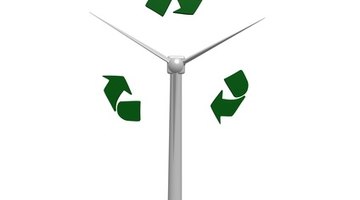How to Build a Wind Generator Using a Delco Alternator
If you have an extra Delco alternator, you may want to consider generating your own electricity via a wind turbine system. Although automobile alternators do not make for the best wind turbines, you can modify the alternator so that it is adjusted for lower revolutions per minute (RPMs), thereby producing more electricity than it would otherwise. There are several variations of renewable-energy systems, ranging from grid-connected systems, battery backup systems and systems connected directly to your circuit breaker box.

-
Use a socket wrench and screwdriver to open the alternator, exposing the wired coils within. Detach the coils and unwind the wires. Rewind the coils with thinner gauge wire, which will help to gear the alternator for lower RPMs and greater electricity production as a wind turbine.
-
Use a tap-and-dye set to drill holes into the gear on the alternator's drive shaft. Bolt in wind turbine generator blades (Windmax brand recommended) to the gear, which will now be referred to as the blade hub. Spin the turbine's blades and attach a multimeter set to voltage to the electrodes on the alternator to measure the production of electricity. If it does not produce electricity, you may need to use smaller wires for the alternator coils.
-
Use waterproof plastic containers to enclose the turbine system, cutting out holes for the blade hub and wiring for the terminals at the rear of the turbine. Use packaging styrofoam glued into the bottoms and sides of the plastic containers to help absorb vibration from the wind turbine system.
-
Screw in 12-gauge AWG (American Wire Gauge) cable to the positive and negative terminals on the alternator. The black wire should connect to the positive terminal and the white wire to the negative terminal. Solder the green wire to an old TV or ham radio tower as a ground.
-
Run the 12-gauge cable to the battery bank, including extra length in the wire for raising the turbine on top of the TV tower. Solder the end of the 12-gauge cable to a blocking diode, which prevents the batteries from turning the turbine. Connect a short length of 12-gauge cable to the output of the blocking diode, then connect the opposite end of the wire to a charge controller. The charge controller helps to regulate the recharge cycles of the battery bank, ensuring the longevity of the batteries.
-
Use the 12-gauge cable to wire two outputs from the charge controller. The primary output should be attached to the terminals on a deep cycle battery using soldered eyelets on the wire-ends. The secondary output should be attached to a dump load, which will act as a heat sink to disperse extra electricity produced by your RE system.
-
Use battery cables to connect the deep cycle batteries into a series circuit, which allows the individual voltages of the batteries to be added for total system voltage for your home appliances. Connect opposing terminals in order to achieve the series circuit configuration, linking the positive terminal of one battery to the negative terminal of its adjacent battery.
-
Connect the positive and negative terminals from a battery to a power inverter, which converts the electricity into Alternating Current (AC), which is used by nearly all home appliances. Different power inverters will have different wiring specifications for their input terminals. Connect an extension cord to your power inverter and use a power strip to access the power from your RE system's battery bank.
-
Solder or weld steel brackets onto the TV tower. Bolt your turbine to the tower and raise it using winches, ropes and pulleys. Different tower designs may call for concrete footers or guy lines for added support.
References
Resources
Writer Bio
David McGuffin is a writer from Asheville, N.C. and began writing professionally in 2009. He has Bachelor of Arts degrees from the University of North Carolina, Asheville and Montreat College in history and music, and a Bachelor of Science in outdoor education. McGuffin is recognized as an Undergraduate Research Scholar for publishing original research on postmodern music theory and analysis.
Photo Credits
- wind turbine recycle image by redrex from Fotolia.com
More Articles



